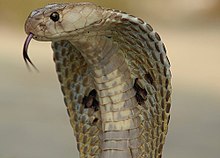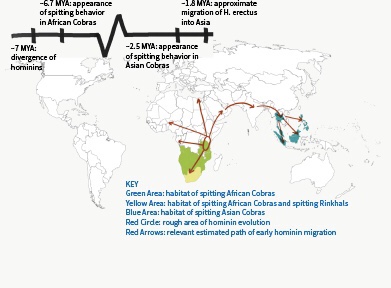Study on Evolution of Spitting Cobra Venom Suggests Potential Correlation with Hominin Evolution
This webpage was produced for an undergraduate course at Davidson college.
Venom Genomics
Hominins may have functioned as a selective pressure toward long-range defense mechanisms, namely spitting, in groups of cobras and rinkhals.
Understanding the components of snake venom is not merely important to medically treat those with bites; it provides a clear, evidence-based study of the evolution of animal behavior and offers insights into human and primate evolution, as well. In looking at the venom of spitting cobras and rinkhals, Kazandjian et. al. develop a picture of a potential evolutionary arms race between early humans and snakes, which has shaped the defense capacities of both species: the cognition of humans and, in the case of the snakes studied, the components and delivery of venom.
With few exceptions, most snakes will react to threats by attempting to flee, curling up tightly around themselves to protect their delicate heads, or playing dead (Gehlbach, 1970). In short, their defenses are non-aggressive. Given that snakes have a lot to lose in a fight, this makes sense. As a result, rather than defensive, selection favored predatory venoms and delivery mechanisms in most snakes (Gehlbach, 1970). However, a few snakes exhibit fundamentally different behavior defensively. this article will discuss three such lineages: one of cobras in Africa, one of cobras in Asia, and one of rinkhals in Africa (Kazandjian et. al., 2021). It’s important to note that these groups all share a common ancestor, as they fit within the snake family Elapidae. These lineages engage in a defensive practice called “spitting,” the act of projecting venom at a threat in order to defend themselves (Kazandjian et. al., 2021).
Many cobras and rinkhals, even those that do not exhibit spitting, do exhibit a defensive posture called “hooding,” where they flare out of a part of their head and neck and rear up to appear larger and more threatening to potential threats (Young et. al., 2010). These groups also exhibit significantly more aggressive tendencies than other snakes, including other members of their family. These pre-existing defensive practices may have been the behavioral precursor to spitting. This paper studies the venom of spitting in juxtaposition with that of their non-spitting close relatives (Kazandjian et. al., 2021).

Snake venom can be broken down into three general categories, though more than one kind may make up components of the venom of a given species. The first is cytotoxic, which destroys the membranes of individual cells. The second type is hemotoxic, which damages the circulatory system and muscle tissue, and the third is neurotoxic, which damage the nervous system and can lead to paralysis. Most elapid venoms are neurotoxic, including most cobra and rinkhal venoms. Kazandjian et. al. investigate the components of spitting cobra and rinkhal venoms and juxtapose them with the components of the venoms of their non-spitting close relatives. Doing so revealed that the venoms of spitting elapids are slightly more cytotoxic than their counterparts (Kazandjian et. al., 2021). Spitting venoms are often targeted at blinding a potential predator, so the combination of cytotoxic and neurotoxic components would maximize the effectiveness of doing so. Lab tests on non-sentient chick embryos confirmed the connection between cytotoxicity and eye irritation (Kazandjian et. al., 2021). Kazandjian et. al. also looked at the effect of another enzymatic venom component referred to as “PLA2s,” which were significantly more common across the board in the venom of spitting elapids when compared to close relatives.
After ascertaining the components of the venom, the study examined when these characteristics may have evolved. Understanding when these characteristics appeared allows Kazandjian et. al. to consider the known circumstances in which they evolved and extrapolate potential selection factors. In African spitting cobras, they were able to determine that spitting behaviors and specific venoms would have appeared approximately 6.7 million years ago.2 Around 7 million years ago, in the same region, hominins (members of the genus Homo, including humans), first diverged from their closest relatives, members of the genus Pan (including chimpanzees and bonobos) (Aranson et. al., 2004). Similarly, in Asian spitting cobras, the estimate for when the spitting behaviors evolved was around 2.5 million years ago, which, though earlier than the arrival of the migrating Homo erectus population that settled there around 1.8 million years ago, is important to contextualize by stating that Kazandjian et. al. consider these times to be close enough to be significant.

A compelling explanation for hominins acting as the selective pressure comes from connecting this research to earlier bodies of work that suggest that snakes acted as a selective pressure on hominin evolution (Kazandjian et. al., 2021; Kawai and He, 2016; Isbell, 2006).Earlier research points to the neurobiology of humans and macaque monkeys in response to snakes: children of both species react in fear, at a rate significantly faster than done for other species, and they do so without prior exposure to the animals (Kawai and He, 2016). Additionally, unlike most mammalian predators, hominins have historically hunted by relying on their visual acuity. It would be prudent to consider hominin hunting practices as a possible selective pressure on a venom that has been selected to blind targets, most likely visual predators. Hominins could also distinguish between harmless and dangerous species, practicing a form of preemptive self-defense by killing harmful species when they ran across them. Kazandjian et. al. also discuss the uniquely hominin use of long-range weapons to do so, which might have acted as a selection pressure for long-range defense (Kazandjian et. al., 2021).
It’s important to understand the components of snake venom for medical reasons, but this paper has given support to a second reason: framing snake and hominin evolution as agents of selection on each other. It not only helps humans understand why some types of snakes will flee or attack humans, but how the human brain and instincts have been shaped by fear of snake predation. Past studies have considered whether memory was selected during early hominin evolution as a way of escaping predation and threats (Howe, 2011). Understanding that the evolution of memory also shapes how it is used in the modern world may impact the way that we view mental healthcare (Yue, 2018).
Brosschot et. al. considers the possibility that anxiety was an evolutionary process that shaped the human mind and allowed the survival and success of our species. However, those same tools, including memory and fear, now function in ways that aren’t beneficial, as most people in America and Europe in the twenty-first century are significantly more likely to suffer from a mental illness than to face attack by the predator that may have selected for that innate response. Knowing where something came from, in what circumstances it may have been beneficial, and the specific ways that those past benefits are rubbing against present circumstances to create a distinct disadvantage is critical. It could potentially help mental health professionals and researchers to better treat their patients in ways that take into consideration the full picture. In biology, behaviors in many animals are treated in a comprehensive way, by looking at the trait from four perspectives. The first is looking at where it evolved from and why it was selected for. The second is looking at where it appeared developmentally in each individual. The third is looking at how it might connect to the animal’s survival now and the fourth is looking at how it is currently used and whether or not that use benefits the animal (Tinbergen, 1963). Considering how humans may have acted as an agent of selection on snakes provides context for how we reacted to them, which offers a lens into the circumstances in which a connection between fear, anxiety, and memory was beneficial. Understanding this human trait comprehensively may provide long-term insights, not just into our evolution, but into how it affects us now and how to treat any detrimental effects successfully.
References:
Arnason, Ulfur, et al. “Molecular estimates of primate divergences and new hypotheses for primate dispersal and the origin of modern humans.” Hereditas 133.3 (2001): 217-228.
Brosschot, Jos F., Bart Verkuil, and Julian F. Thayer. “The default response to uncertainty and the importance of perceived safety in anxiety and stress: An evolution-theoretical perspective.” Journal of Anxiety Disorders 41 (2016): 22-34.
Gehlbach, Frederick R. “Death-feigning and erratic behavior in leptotyphlopid, colubrid, and elapid snakes.” Herpetologica (1970): 24-34.
Howe, Mark L. The nature of early memory: An adaptive theory of the genesis and development of memory. Oxford University Press, 2011.
Isbell, Lynne A. “Snakes as agents of evolutionary change in primate brains.” Journal of human evolution 51.1 (2006): 1-35.
Kawai, Nobuyuki, and Hongshen He. “Breaking snake camouflage: Humans detect snakes more accurately than other animals under less discernible visual conditions.” PLoS One 11.10 (2016): e0164342.
Kazandjian, Taline D., et al. “Convergent evolution of pain-inducing defensive venom components in spitting cobras.” Science 371.6527 (2021): 386-390.
Tinbergen, Niko. “On aims and methods of ethology.” Zeitschrift für Tierpsychologie 20.4 (1963): 410-433.
Young, Bruce A., and Kenneth V. Kardong. “The functional morphology of hooding in cobras.” Journal of Experimental Biology 213.9 (2010): 1521-1528.
Yue, Jingli, et al. “Behavioral interventions to eliminate fear responses.” Science China Life Sciences 61.6 (2018): 625-632.